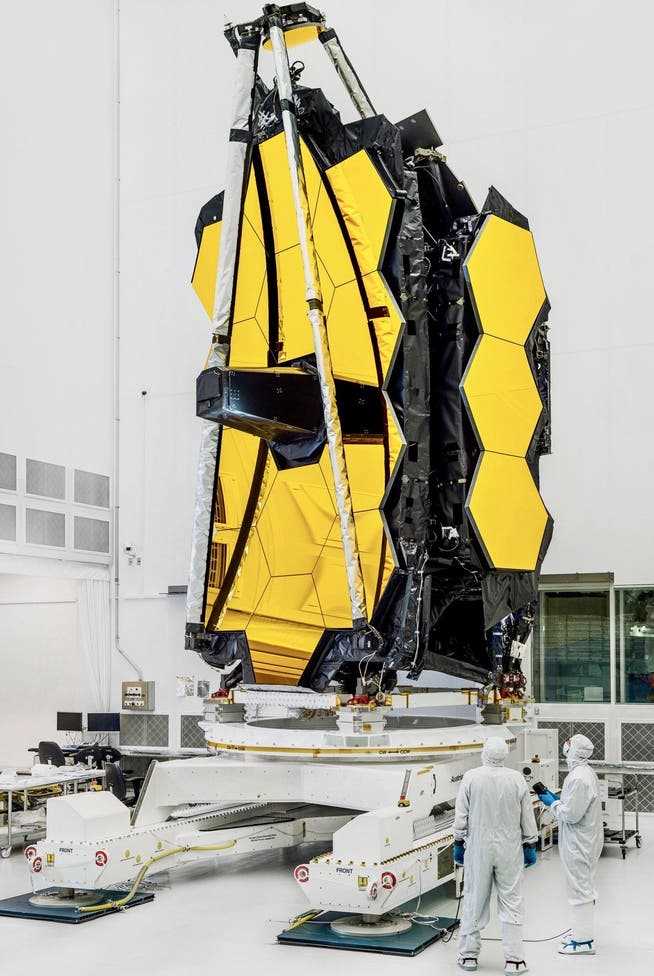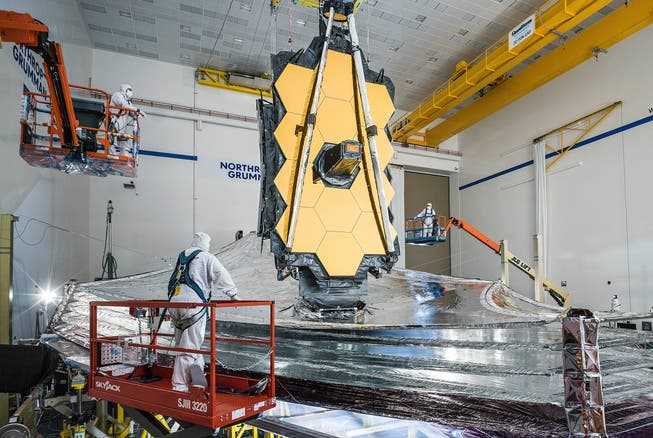The James Webb Telescope brings us closer to the moment when the lights came on in the universe. First of all, however, the telescope has to survive the journey to its destination. The start is scheduled for this Saturday.
The mirror of the James Webb telescope, which consists of 18 segments, is tested in the clean room laboratory.
When the Hubble Space Telescope took to the stage in April 1990, the world was still another. The British physicist Tim Berners-Lee had just presented the idea for the World Wide Web at Cern in Geneva. An East German politician named Angela Merkel was preparing to win her first mandate in the Bundestag. And mankind was allowed to indulge in the illusion that there was nothing comparable on earth in the vastness of the universe.
After more than thirty years of service, the era of the Hubble telescope is slowly coming to an end. But with the James Webb Space Telescope, a successor is already in the starting blocks, which will catapult astronomy into new spheres. After decades of planning, cost explosions and several postponements, the largest and most powerful telescope in space history is set to set off into space on Saturday (1:00 p.m. 8:00 p.m. CEST).
The expectations are “astronomical”. Some researchers prophesy, the James Webb Telescope will take astronomy further in ten years than any discoveries made since the time of Galileo Galileo. And even sober researchers are not stingy with superlatives. The tension before the start is correspondingly high.
A deep look into the past
With its 6.5 meter mirror, the telescope is around a hundred times as sensitive to light as the Hubble telescope. Astronomers want to use it to look back to the early epoch of the universe when the first stars and galaxies formed from hydrogen and helium. And they want to follow how these protogalaxies became majestic structures like the Milky Way, which populate today’s universe.
The light of the first stars and galaxies was an estimated 13.5 billion years before it reached us. During this period, the universe has expanded by a factor of roughly 20. With the expansion of space, the wavelength of light was also stretched. That is why the James Webb telescope operates in the infrared wavelength range. The first stars and galaxies would not be visible in the visible area.
This also suits astronomers who are more concerned with the here and now. Since the discovery of the first extrasolar planet by the Geneva researchers Didier Queloz and Michel Mayor in 1995, the question has arisen as to whether there could be other stars with life-friendly planets in our Milky Way.
The answer could be hidden in the atmosphere of the extrasolar planets. Many of the molecules associated with primitive life absorb infrared light. With the James Webb Telescope, one can systematically search for such signatures of life for the first time. This marks the beginning of a new era of planetary research that promises more class than mass.
So far, the main aim has been to track down as many extrasolar planets as possible, now the aim is to pick out the most interesting candidates in order to characterize their atmosphere more precisely. On the astronomers wish list, for example, is the Trappist-1 system, which consists of seven planets. Because three of the seven planets orbit in the habitable zone of their star, in which water could exist in liquid form. That makes the planetary system extremely interesting.
All of this is not available for free. The James Webb Telescope, a joint project between NASA, ESA and the Canadian Space Agency, carries a price tag of ten billion dollars. It was not foreseeable that it would be so expensive. When the first ideas for a successor to the Hubble telescope (which was not yet in space at that time) were rolled out in the USA in the late 1980s, a figure of $ 500 million was in the room. But with the planning, so did the demands.
Why so humble?
Nasa was not entirely innocent of this. In 1996, the astronomers had to be accused by the then NASA administrator, Dan Goldin, of being too modest. Instead of settling for a 4-meter telescope, think about how to build a space telescope with a mirror diameter of 6 meters or more.
Goldin’s suggestion fell on fertile ground. It had to do with a groundbreaking discovery the Hubble telescope had made recently. In December 1995, astronomers aimed the telescope at a small spot in the sky that appeared to be almost empty. This spot was targeted for ten days – half an eternity when you consider how short the observation time of a telescope is.

A picture that has made history: the “Hubble Deep Field” shows galaxies where previously only a black spot could be seen.
The criticism was correspondingly loud. Many astronomers were convinced that nothing would be seen. But they were taught otherwise. On the “Hubble Deep Field”, as the famous image is called, researchers identified almost 3,000 galaxies that no telescope had seen before. Some of them were reddish and irregular in shape. This led to the conclusion that galaxy evolution must have started much earlier than previously assumed. But it was not possible to trace them back to their origins. For that you needed a telescope that is not just a little better than the Hubble telescope, but much better.
The decision in favor of a 6.5 meter mirror posed serious problems for the technicians. Because a mirror of this size does not fit in the hold of conventional payload rockets. In addition, it would be much too heavy together with the load-bearing elements. In contrast to the Hubble telescope, the mirror of the James Webb telescope could not be made from a single cast. It had to be light and foldable.
A folding mirror
After much back and forth, the decision was made to build a mirror from 18 hexagonal segments, which only unfolds to its full size in space. 132 tiny motors are supposed to ensure that the 1.3 meter large and 40 kilogram heavy beryllium segments are aligned so that they work together like a large monolithic mirror. The highest level of precision is required. A mistake in the nanometer range is enough and the mirror no longer focuses the infrared light sharply on the scientific instruments, which are then supposed to break it down into its spectral components and analyze it.

So that the James Webb telescope fits into the hold of the Ariane 5 rocket, its two side wings are folded.
Like all steps, the unfolding of the mirror was also tested in detail in the laboratory, says Adrian Glauser from ETH Zurich. Glauser helped develop the Mid Infrared Instrument (Miri), one of four scientific instruments in the James Webb Telescope. We learned from the mishap of the Hubble telescope, which was launched in 1990 with faulty optics. The visual defect could only be corrected through an expensive astronaut mission.
There will be no such rescue operation with the James Webb Telescope. Because unlike the Hubble telescope, its successor does not orbit the earth in a near-earth orbit. After the launch with a European Ariane 5 rocket, a one-month journey begins, which ends at the so-called Lagrange point L2. This is 1.5 million kilometers from Earth.
If something goes wrong on this journey – and there are many things that can go wrong with this complex mission – the James Webb Telescope can be written off. That explains why so many astronomers are very nervous right now. Failure would set them back years.
The Lagrange point L2 is the best point to operate an infrared telescope, says Glauser. This point revolves around the sun synchronously with the earth, so that the two celestial bodies would always be on one line. This makes it possible to shield the heat radiation from the sun and earth at the same time with a heat shield. For an infrared telescope, this is decisive for the match. Because even the low heat radiation from the earth disturbs the sensitive instruments considerably.
Warmth is the greatest enemy
In fact, the heat shield has to withstand extreme temperature differences. On the underside, it heats up to 85 degrees Celsius. On the other hand, on the upper side, where the mirror and the scientific instruments are located, there is a frosty –233 degrees. This corresponds almost to the operating temperature of the instruments. Sophisticated cooling systems take care of the rest.
This is made possible by a thin plastic membrane consisting of five layers. Each layer absorbs part of the heat and radiates it off to the side. In this way, a temperature difference of more than 300 degrees can be maintained over the long term. Especially for the Miri, the coldest instrument in the telescope, it would be catastrophic if the heat shield did not unfold correctly, says Glauser. The only thing worse is a failure of the power supply.

A multi-layer protective shield is designed to shield the James Webb telescope from heat radiation from the sun and earth.
These problems are not entirely new. Both NASA and ESA have had experience with infrared space telescopes in the past. ESA’s Herschel telescope was in operation from 2009 to 2013, and NASA’s Spitzer telescope even from 2003 to 2009. After that, the supply of liquid helium required for cooling was exhausted.
The James Webb Telescope will not hold out much longer. The duration of the mission is set for five years, says Glauser. But everyone hopes that the telescope can be used for ten years. The limiting factor this time around is not the coolant. Rather, the service life depends on how much fuel is used to bring the telescope onto its target course after takeoff. What is lost in fuel in this phase is missing later to keep the telescope in its orbit around the Lagrange point.
It is therefore clear: The James Webb Telescope may revolutionize astronomy in the next ten years. But in thirty years we will probably be talking about completely different space telescopes.
Follow the science desk of the NZZ Twitter.
